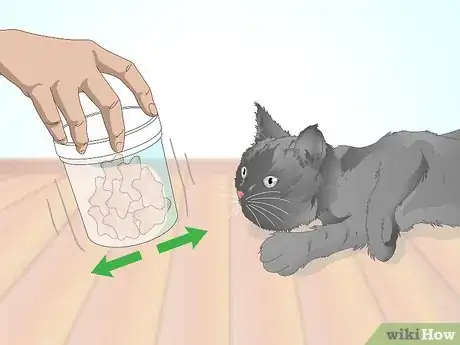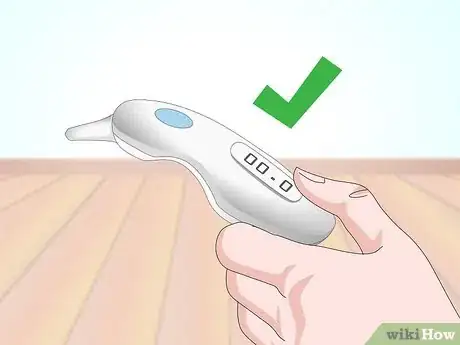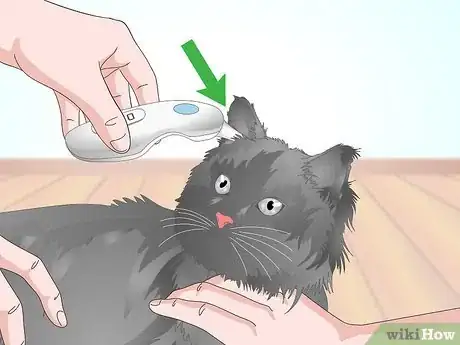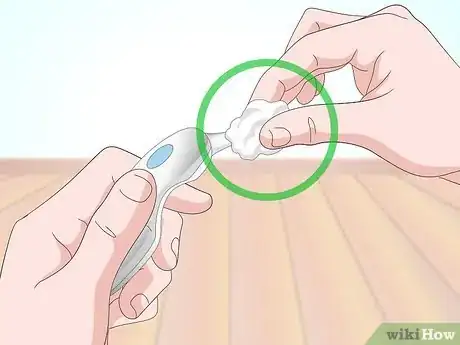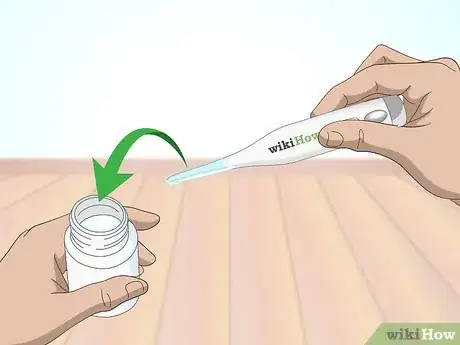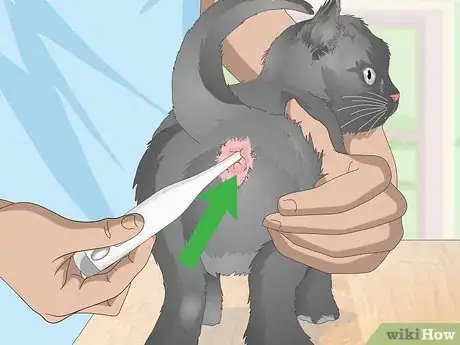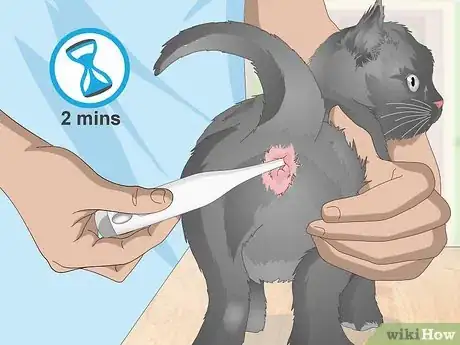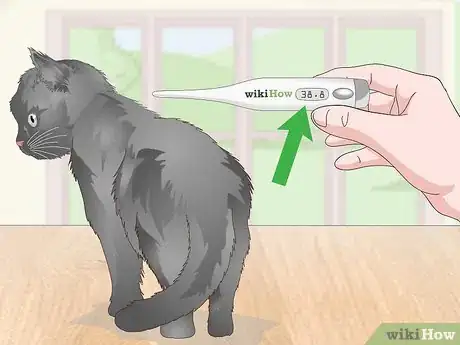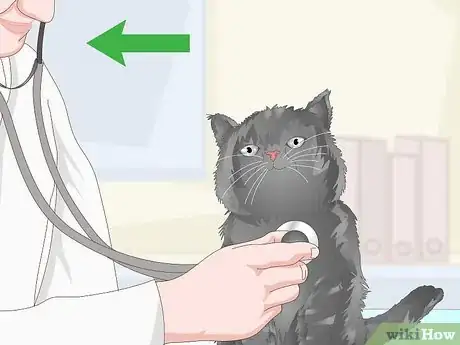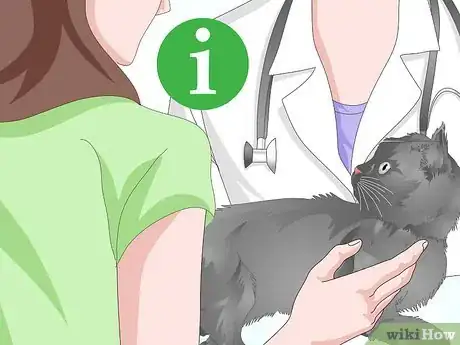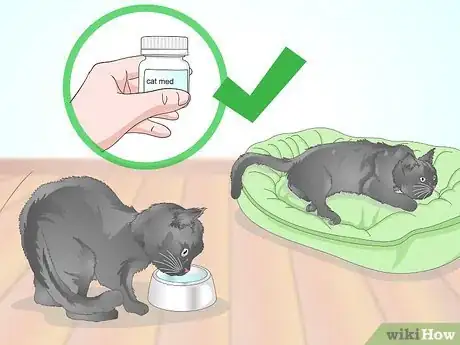This article was co-authored by Brian Bourquin, DVM. Brian Bourquin, better known as “Dr. B” to his clients, is a Veterinarian and the Owner of Boston Veterinary Clinic, a pet health care and veterinary clinic with three locations, South End/Bay Village, the Seaport, and Brookline, Massachusetts. Boston Veterinary Clinic specializes in primary veterinary care, including wellness and preventative care, sick and emergency care, soft-tissue surgery, dentistry. The clinic also provides specialty services in behavior, nutrition, and alternative pain management therapies using acupuncture, and therapeutic laser treatments. Boston Veterinary Clinic is an AAHA (American Animal Hospital Association) accredited hospital and Boston’s first Fear Free Certified Clinic. Brian has over 19 years of veterinary experience and earned his Doctor of Veterinary Medicine from Cornell University.
wikiHow marks an article as reader-approved once it receives enough positive feedback. This article received 21 testimonials and 100% of readers who voted found it helpful, earning it our reader-approved status.
This article has been viewed 392,381 times.
Cats, like humans, develop fevers when sick. Unfortunately, the methods used on humans don’t work for cats. Feeling your cat's forehead is not a trustworthy method. The only accurate way to check your cat's temperature at home is with a thermometer inserted into its rectum or ear. As you can understand, your cat won’t enjoy this procedure or being held against its will. In order to determine if you need to take your cat’s temperature at all, you should look out for specific symptoms. Then you’ll want to check its temperature with as little stress as possible. Lastly, if your cat’s temperature exceeds 103 degrees Fahrenheit, you should seek help from your veterinarian.
Steps
Recognizing Cat Fever Symptoms
-
1Look for behavioral changes. If your cat is normally playful, active, and generally friendly, reclusiveness could be a sign that your cat is sick.[1] If it starts hanging out under your bed, couch, table, or any other out of reach, unusual place, this could be a sign. Cats are instinctively cautious creatures, even if they might be playfully curious on any given day. If your cat is sick, it will want to reduce his or her vulnerability by hiding from you.
-
2Take note of your cat’s appetite.[2] If your cat is accustomed to eating at a specific time or normally eats a certain amount of food each day, it may alter this behavior if it’s sick. Check your cat’s food bowl throughout the day to see if it has eaten anything.
- If this is the case, try tempting your cat with slight more “exciting” food options. Even consider bringing their food bowl to them. If they are hiding because they don’t feel well, they might not be confident enough to venture out to their normal feeding place. If you place the bowl in their safe zone, they might be more inclined to eat.
Advertisement -
3Look out for vomiting or diarrhea. Many cat illnesses — ranging from colds to more serious diseases or conditions — produce fevers, but may also cause other symptoms like vomiting and diarrhea. Check your cat’s litter box area. In some cases, your cat may attempt to bury this. If you have an outdoor cat, try to follow it. Check its resting areas for disturbed dirt if it normally buries its business.
-
4See if your cat is extra lethargic. This is a tough symptom to identify because cats are notoriously lazy creatures. If your cat refuses to get up when you shake a treat bag, it might be lethargic. If your cat normally likes to follow you from room to room, but remains content sleeping all day in a room away from you, it might be lethargic. If you think your cat shows signs of sluggish behavior, be sure to tell your veterinarian.
Taking Your Cat’s Ear Temperature
-
1Use an ear thermometer that is specially designed for cats and dogs. These have longer arms that better reach into the pet's ear canal. These thermometers can be purchased at pet specialty shops or at some veterinarian's offices. In general, these thermometers are not as effective as rectal thermometers.[3] If your cat is feisty, it might sit still for an ear thermometer rather than a rectal one.
-
2Restrain your cat. Hold their body firmly with their paws on a surface (try using the floor). Be sure to hold its head in your arm firmly. You don’t want your cat to buck or pull its head while you are taking its temperature. Have a friend help with this too if you have that option.[4]
-
3Place the thermometer deep into the animal's ear canal. Follow the manufacturer's directions to determine when the reading is complete. Ear thermometers take roughly the same amount of time to register a temperature as a rectal thermometer. It will take a couple of minutes.
-
4Clean off the thermometer and put away. Just like for any thermometer, you'll want to clean it thoroughly with soapy water or rubbing alcohol after use. After you've done this, put the thermometer away in a designated place.[5]
Taking Your Cat’s Rectal Temperature
-
1Prepare the thermometer ahead of time. Shake the thermometer well if you are using one that contains mercury. A digital thermometer may also be used and typically gives a faster result. It is recommended that you use a disposable sleeve with a digital thermometer.[6]
-
2Lubricate the thermometer with petroleum or other water-based lubricating jelly. KY Jelly or Vaseline works well. Your goal is to make this process as stress-free for the cat as possible. Using lubrication helps decrease the risk of abrasion, ripping, and puncturing.[7]
-
3Position the cat correctly. Hold the cat under one arm like a football, with its tail towards the front of your body. Make sure its feet are on a solid surface like a table. Doing so will reduce the likelihood of scratches.
- It may be a good idea to have a friend help you hold the cat if possible. Some cats are wiggly and may be difficult to keep still. Have your helper position the cat in a way so that you can insert the thermometer in its rectum easily.
- You might also grab and hold onto your cat’s scruff (extra skin on the back of its neck). Since many cats associate this with their mother’s protection, it may have a calming effect. [8]
-
4Insert the thermometer into the cat's rectum. Be sure to only insert the thermometer approximately 1 inch (2.54 cm). Do not go more than 2 inches deep. Hold the thermometer at a 90 degree angle so it goes straight into your cat’s rectum. Do not enter at any other angle as this will increase the likelihood of pain and discomfort.[9]
- If you don't feel comfortable taking your cat's temperature, take it into a vet.[10]
-
5Hold the thermometer in place for approximately 2 minutes. A mercury thermometer may take a little longer to get an accurate reading. If you are using a digital thermometer, hold it until it indicates that it has finished reading the temperature. Most digital thermometers will beep when finished.[11]
- Hold your cat firmly during this process. It may squirm, scratch, or bite. Do your best to keep it still to avoid injury to your cat and yourself.
-
6Read the result. A temperature of 101.4 degrees F (38.55 degrees C) is ideal for a cat, but a cat's temperature may also range from 100 to 102.5 degrees F (39.17 degrees C) and still be considered normal. [12]
- If your cat's temperature is below 99 degrees F (37.22 degrees C) or above 104 degrees F (40 degrees C) you should seek immediate medical attention.
- If your cat's temperature is approaching 103 degrees F (39.44 degrees C) or over, and your cat is acting unwell, also seek veterinary attention.
-
7Clean off the thermometer. Use warm, soapy water or rubbing alcohol to rinse and wipe off the thermometer. If you used a cover sheet for the thermometer, remove the sheet and wash the thermometer as instructed.[13] Make sure that it is completely sanitized before storing it.
Visiting the Veterinarian
-
1See the vet if your cat has a temperature below 99 or above 102.5 degrees Fahrenheit. In many cases, your cat will be able to overcome a fever on its own, but it is always a good idea to consult your vet. If your cat is sick for several days or you suspect a chronic condition, it is even more important that you visit your vet.
-
2Explain your cat’s symptoms. In addition to telling the vet that your cat has had a fever, be sure to tell your vet any other symptoms that your cat has exhibited. This is important information that your vet can use to determine a diagnosis.
-
3Follow your vet’s instructions explicitly. Depending on the vet’s diagnosis, you may simply need to keep your cat hydrated and comfortable. If your vet suspects infection or something else, you might have to administer medicine.
Expert Q&A
Did you know you can get expert answers for this article?
Unlock expert answers by supporting wikiHow
-
QuestionWhat happens when a cat has a fever?
 Brian Bourquin, DVMBrian Bourquin, better known as “Dr. B” to his clients, is a Veterinarian and the Owner of Boston Veterinary Clinic, a pet health care and veterinary clinic with three locations, South End/Bay Village, the Seaport, and Brookline, Massachusetts. Boston Veterinary Clinic specializes in primary veterinary care, including wellness and preventative care, sick and emergency care, soft-tissue surgery, dentistry. The clinic also provides specialty services in behavior, nutrition, and alternative pain management therapies using acupuncture, and therapeutic laser treatments. Boston Veterinary Clinic is an AAHA (American Animal Hospital Association) accredited hospital and Boston’s first Fear Free Certified Clinic. Brian has over 19 years of veterinary experience and earned his Doctor of Veterinary Medicine from Cornell University.
Brian Bourquin, DVMBrian Bourquin, better known as “Dr. B” to his clients, is a Veterinarian and the Owner of Boston Veterinary Clinic, a pet health care and veterinary clinic with three locations, South End/Bay Village, the Seaport, and Brookline, Massachusetts. Boston Veterinary Clinic specializes in primary veterinary care, including wellness and preventative care, sick and emergency care, soft-tissue surgery, dentistry. The clinic also provides specialty services in behavior, nutrition, and alternative pain management therapies using acupuncture, and therapeutic laser treatments. Boston Veterinary Clinic is an AAHA (American Animal Hospital Association) accredited hospital and Boston’s first Fear Free Certified Clinic. Brian has over 19 years of veterinary experience and earned his Doctor of Veterinary Medicine from Cornell University.
Veterinarian
-
QuestionMy cat sneezes a lot and isn't herself. Is she sick?
 Pippa Elliott, MRCVSDr. Elliott, BVMS, MRCVS is a veterinarian with over 30 years of experience in veterinary surgery and companion animal practice. She graduated from the University of Glasgow in 1987 with a degree in veterinary medicine and surgery. She has worked at the same animal clinic in her hometown for over 20 years.
Pippa Elliott, MRCVSDr. Elliott, BVMS, MRCVS is a veterinarian with over 30 years of experience in veterinary surgery and companion animal practice. She graduated from the University of Glasgow in 1987 with a degree in veterinary medicine and surgery. She has worked at the same animal clinic in her hometown for over 20 years.
Veterinarian Sneezing, along with altered behavior, can be indicative of illness. Try and encourage her to eat, which will keep her strength up to fight any infection. Watch to see how much she eats and drinks, and check the litter tray to see if her poop is normal or not. If you are worried, especially if she isn't eating or drinking, then a vet check is always the best option.
Sneezing, along with altered behavior, can be indicative of illness. Try and encourage her to eat, which will keep her strength up to fight any infection. Watch to see how much she eats and drinks, and check the litter tray to see if her poop is normal or not. If you are worried, especially if she isn't eating or drinking, then a vet check is always the best option. -
QuestionHow can I tell if my cat has a cold?
 Pippa Elliott, MRCVSDr. Elliott, BVMS, MRCVS is a veterinarian with over 30 years of experience in veterinary surgery and companion animal practice. She graduated from the University of Glasgow in 1987 with a degree in veterinary medicine and surgery. She has worked at the same animal clinic in her hometown for over 20 years.
Pippa Elliott, MRCVSDr. Elliott, BVMS, MRCVS is a veterinarian with over 30 years of experience in veterinary surgery and companion animal practice. She graduated from the University of Glasgow in 1987 with a degree in veterinary medicine and surgery. She has worked at the same animal clinic in her hometown for over 20 years.
Veterinarian
Warnings
- It is recommended that you take both a rectal and ear reading for the first few times to ensure the accuracy of the ear thermometer.⧼thumbs_response⧽
- Do not attempt to give your cat fever reducing medications or sponge baths to reduce fever. Always consult a veterinarian before attempting to treat a cat's illness.⧼thumbs_response⧽
References
- ↑ Brian Bourquin, DVM. Veterinarian. Expert Interview. 20 December 2019.
- ↑ Brian Bourquin, DVM. Veterinarian. Expert Interview. 20 December 2019.
- ↑ http://www.petplace.com/article/cats/first-aid-for-cats/nursing-care-for-sick-cats/how-to-take-your-cats-temperature
- ↑ http://www.petplace.com/article/cats/first-aid-for-cats/nursing-care-for-sick-cats/how-to-take-your-cats-temperature
- ↑ http://www.vetstreet.com/dr-marty-becker/check-your-cats-vital-signs-at-home
- ↑ http://m.petmd.com/blogs/thedailyvet/ken-tudor/2015/february/do-you-have-take-my-pets-temperature-rectally-32510
- ↑ http://m.petmd.com/blogs/thedailyvet/ken-tudor/2015/february/do-you-have-take-my-pets-temperature-rectally-32510
- ↑ http://www.vetstreet.com/dr-marty-becker/check-your-cats-vital-signs-at-home
- ↑ http://www.vetstreet.com/dr-marty-becker/check-your-cats-vital-signs-at-home
- ↑ Brian Bourquin, DVM. Veterinarian. Expert Interview. 20 December 2019.
- ↑ http://www.vetstreet.com/dr-marty-becker/check-your-cats-vital-signs-at-home
- ↑ http://www.vetstreet.com/dr-marty-becker/check-your-cats-vital-signs-at-home
- ↑ http://www.vetstreet.com/dr-marty-becker/check-your-cats-vital-signs-at-home
About This Article
To tell if your cat has a fever, start by looking out for behavioral changes, such as hiding under a bed or table if the cat is usually playful. Pay attention to your cat's appetite, because your pet may eat less or not eat at the usual time if it's sick. In addition, you should check your cat's litter box or follow it outside in case it has diarrhea or has vomited. If you decide to take the cat's temperature, seek immediate medical assistance if it's below 99 degrees F or above 104 degrees F. To find out how to take your cat's temperature using a rectal thermometer or ear thermometer, read on!




